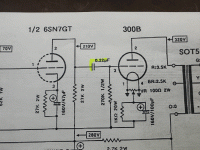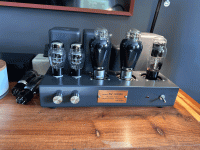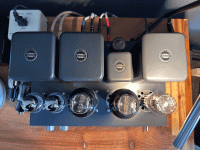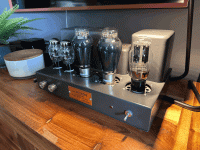Hello to everyone....I am hoping you can help recommend components that will allow me to swap out coupling capacitors in a tube amplifier?
I wish to be able to swap out coupling capacitors to hear differences in sound quality. I understand the differences may be very small but it's the road I wish to go down.
Has anyone else created this with their tube amp and are there any connectors that will allow me to place the capacitor leads into their respective socket. I plan on having this option external from the amp. Looking for female connectors to place the capacitor leads into.
I got this idea from my preamp which allows me to select load resistors and has the ability to add custom loading.
Thanks in advance for your all help.
Bill in Nova Scotia, Canada
I wish to be able to swap out coupling capacitors to hear differences in sound quality. I understand the differences may be very small but it's the road I wish to go down.
Has anyone else created this with their tube amp and are there any connectors that will allow me to place the capacitor leads into their respective socket. I plan on having this option external from the amp. Looking for female connectors to place the capacitor leads into.
I got this idea from my preamp which allows me to select load resistors and has the ability to add custom loading.
Thanks in advance for your all help.
Bill in Nova Scotia, Canada
Last edited:
Ah, so there is DC voltage. I thought part of the reasoning behind coupling caps were to protect any DC from getting to the grid of the power tube in this instance. But normally there is only low AC voltage at the input of the coupling capacitor? My apologies, I am relatively new at this.
Attachments
Do not extend the capacitor leads beyond the normal cm or two. That is very dangerous.
The entire reason for the capacitor is to block the DC voltage of the first stage from the following component.
This DC voltage could be up to 300V in typical circuits, but any voltage over 50V is considered dangerous.
The entire reason for the capacitor is to block the DC voltage of the first stage from the following component.
This DC voltage could be up to 300V in typical circuits, but any voltage over 50V is considered dangerous.
If you just want to hear differences in coupling capacitors you can leave the original capacitors inside the unit and add a variety of others externally in series using clip leads. Not ideal but perfectly safe.
Not at all "perfectly safe" at all, since clip leads will bring out high DC voltage.
And clip leads often will not be rated adequately in DC voltage for such use.
Not to mention that many such leads are constructed poorly and can slip off easily,
which is even more dangerous. DiyAudio does not endorse such practices, ever.
Of course, such uncontrolled extensions of the circuitry could also cause instability,
noise pickup, and oscillation, possibly damaging the amplifier and your speakers.
And clip leads often will not be rated adequately in DC voltage for such use.
Not to mention that many such leads are constructed poorly and can slip off easily,
which is even more dangerous. DiyAudio does not endorse such practices, ever.
Of course, such uncontrolled extensions of the circuitry could also cause instability,
noise pickup, and oscillation, possibly damaging the amplifier and your speakers.
Andyjevans, I see that this makes sense as well. Certainly an option. I understand the risk of high voltage and not wanting to bring it outside the amp.
I had bought and soldered in place a pair of French teflon SCR coupling caps from Solen here in Canada. The original caps were Japanese and they sounded great too. Just wanted to do a small but expensive tweak in my Japanese 300B amp, lol...then I thought about cap swapping and how it could be done safely. I do understand it can be done safely but I don't want tot go down that road because what if something goes wrong.
I intensively use teflon capacitors -as coupling cap, like V-Cap, russian FT2, FT3- .... but SCR not a cup of tea for me.
The music can become to "clinical", "rigid" with these.
The tin foil versions are little better, but the metalized or aluminium foil no go for me.
I prefer copper foil capacitors -mostly with teflon dielectric- but these are very pricey nowadays.
The old russian teflon capacitors are very good products ... but with horrible dimensions.
p.s.
Partsconnexion sells copper foil capacitors in Canada:
https://partsconnexion.com/capacitors/?_bc_fsnf=1&Type=+Copper+Foil+Polypropylene&Voltage[]=600Vdc&Voltage[]=630Vdc
The music can become to "clinical", "rigid" with these.
The tin foil versions are little better, but the metalized or aluminium foil no go for me.
I prefer copper foil capacitors -mostly with teflon dielectric- but these are very pricey nowadays.
The old russian teflon capacitors are very good products ... but with horrible dimensions.
p.s.
Partsconnexion sells copper foil capacitors in Canada:
https://partsconnexion.com/capacitors/?_bc_fsnf=1&Type=+Copper+Foil+Polypropylene&Voltage[]=600Vdc&Voltage[]=630Vdc
What amp is this if you don't mind me asking?Just wanted to do a small but expensive tweak in my Japanese 300B amp,
jeff
You misunderstood my post - I was suggesting "tasting" coupling caps outside the unit with the origin caps in place. There's no DC on the output. OK, you're listening to 2x capacitors in series but you can still do limited A-B testing.Not at all "perfectly safe" at all, since clip leads will bring out high DC voltage. And clip leads often will not be rated adequately in DC voltage for such use. Not to mention that many such leads are constructed poorly and can slip off easily, which is even more dangerous. DiyAudio does not endorse such practices, ever. Of course, such uncontrolled extensions of the circuitry could also cause instability, noise pickup, and oscillation, possibly damaging the amplifier and your speakers.
FWIW, if your amp uses a PC board for components, I have found this works well.
I've used them for both cathode resistors & coupling caps in an SE amp. I used them to dial in the resistor and to facilitate swapping caps

https://www.digikey.com/en/products/detail/keystone-electronics/8730/2170366
I've used them for both cathode resistors & coupling caps in an SE amp. I used them to dial in the resistor and to facilitate swapping caps
https://www.digikey.com/en/products/detail/keystone-electronics/8730/2170366
It's not expensive but I think it sounds amazing. The amp is Japanese, the Sun Audio SV-300BE and is being used with a step-down transformer. The best I can afford for tubes at this time are the PSVANE 300B Cossor. My dream power tube is the Takatsuki 300B's.What amp is this if you don't mind me asking?
jeff
Presently I am using Northern Electric 6SN7's and a Svetlana black plate 5U4G rectifier tube which is NOS...the other tubes are new. I am very fond of this amp. I also have a Conrad Johnson Classic Sixty SE which I am very proud of as well.
Attachments
"Tonyp063, FWIW, if your amp uses a PC board for components, I have found this works well.
I've used them for both cathode resistors & coupling caps in an SE amp. I used them to dial in the resistor and to facilitate swapping caps"

https://www.digikey.com/en/products/detail/keystone-electronics/8730/2170366
No PC board unfortunately. I know there is a way to make this happen and one just has to be safe about it but I was thinking about drawing out lines for the capacitors from underneath the amp as there are so many large vents. I wanted a semi-permanent solution to make it happen as I didn't want to drill any holes in the casing. I am not a full fledged tech but I can be careful and overly so. I could likely solder the connector you suggested and shrink wrap it well to prevent and shocks or damage to the amp.
I've used them for both cathode resistors & coupling caps in an SE amp. I used them to dial in the resistor and to facilitate swapping caps"
https://www.digikey.com/en/products/detail/keystone-electronics/8730/2170366
No PC board unfortunately. I know there is a way to make this happen and one just has to be safe about it but I was thinking about drawing out lines for the capacitors from underneath the amp as there are so many large vents. I wanted a semi-permanent solution to make it happen as I didn't want to drill any holes in the casing. I am not a full fledged tech but I can be careful and overly so. I could likely solder the connector you suggested and shrink wrap it well to prevent and shocks or damage to the amp.
I asked the seller who I bought it from and he feels it's from the 1980's. The inside is in very good condition as well as the outside. I have always wanted a SET 300B amp and this was found locally in Halifax, Nova Scotia in Canada. Very pleased with this choice. I have this amp paired with two speakers...the Yamaha NS-1000M's and Belle Klipsch's. Very different speakers and the Yamaha's surprise me the most as they work very well together and I can get some very loud music happening. The Klipsch are very efficient and sound very dynamic. Beautiful pairing with either.Nice looking amp. 👍
jeff
Does your Sun Audio 300B amplifier use global negative feedback, that includes the coupling capacitor in the feedback loop?
Or not?
Without global negative feedback . . .
And No DC leakage current . . .
You are more likely to hear any "sound" differences of different coupling caps.
With global negative feedback . . .
As long as all capacitors do Not have any DC leakage current which would then be passed on to the 300B return resistor, RG, (any current would raise the grid DC voltage, changing the 300B bias) . . .
Then the ability to hear the difference between the "sounds" of different coupling capacitors is reduced by the amount of global negative feedback.
(Global negative feedback "Covers" a multitude sins [less than ideal components]).
$0.03
adjusted for inflation
Or not?
Without global negative feedback . . .
And No DC leakage current . . .
You are more likely to hear any "sound" differences of different coupling caps.
With global negative feedback . . .
As long as all capacitors do Not have any DC leakage current which would then be passed on to the 300B return resistor, RG, (any current would raise the grid DC voltage, changing the 300B bias) . . .
Then the ability to hear the difference between the "sounds" of different coupling capacitors is reduced by the amount of global negative feedback.
(Global negative feedback "Covers" a multitude sins [less than ideal components]).
$0.03
adjusted for inflation
Last edited:
- Home
- Amplifiers
- Tubes / Valves
- Swapping Audio Coupling Capacitors in a Tube Amp



